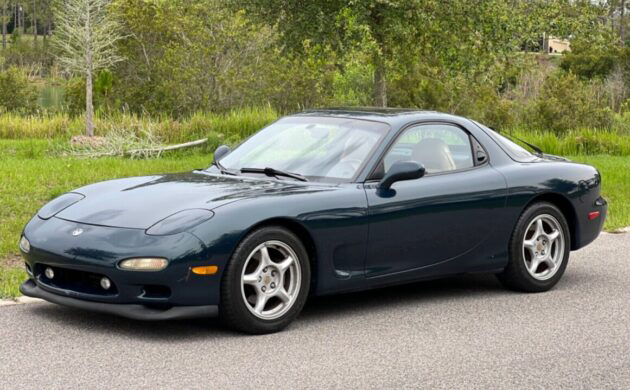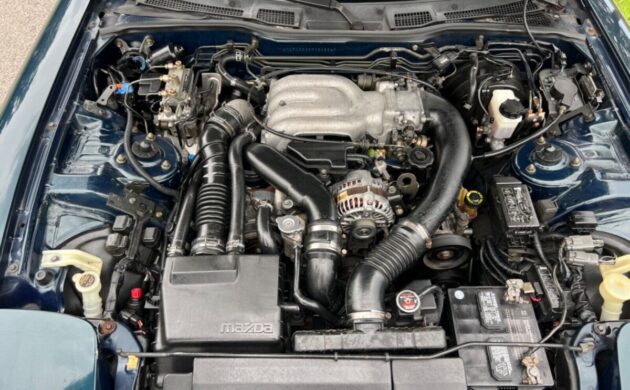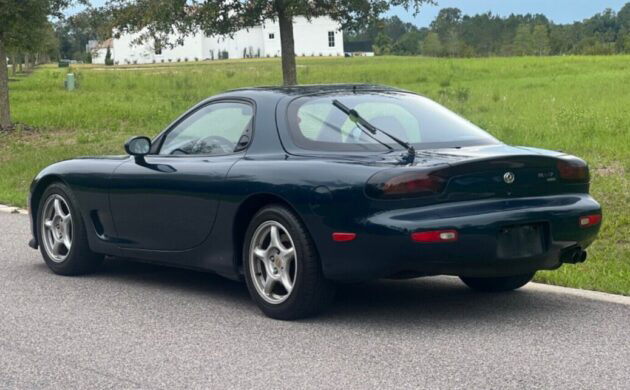Mazda has long been an innovator in the arena of automotive engineering. Its SKYACTIV-X engines are the first commercially available gasoline powerplants to utilize compression ignition. Although the jury is still out, it could prove a game-changer for internal combustion. The same was said of the Wankel rotary decades ago. While Mazda was the most successful at harnessing the potential of these Lilliputian engines, they failed to usurp the reciprocating engine’s hold on power. However, when you add a couple of turbochargers and bolt the motor into a relatively lightweight sports car, the result is a vehicle that demands respect. This 1994 RX-7 is one such car, and its condition and originality are impressive. It is a low-mileage survivor that is set to find a new home. The RX-7 is listed here on eBay in Groveland, Florida. Bidding sits at $21,400 in a No Reserve auction.
The first RX-7 rolled off the production line in 1978, with the badge remaining in production across three generations until 2002. Our feature car is from the Third Generation and presents exceptionally well in Montego Blue Mica. The seller claims this is a rare color, although I can’t find documentary evidence verifying this. The car’s condition is impressive, with no significant flaws or defects in the panels or paint. A close inspection will reveal some chips across the vehicle’s nose because this area is prone. The seller indicates there are a couple of minor dings on the quarter panel, but a paintless dent company should be able to address those. The exterior shows no corrosion, and the underside shots confirm this classic is rust-free and as solid as the day it rolled off the line. It is refreshing to see the owner has avoided the temptation to fit aftermarket spoilers or larger wheels because these are common additions. Its 16″ alloys are spotless, the glass is crystal clear, and the occupants benefit from a factory sliding glass sunroof.
The Mazda’s interior sends mixed messages because while it is presentable, the outer edge of the driver’s seat shows more wear than I would generally expect, considering the odometer reading. However, a couple of factors may have contributed to the problem. The outer bolsters are prone to this type of wear, and if the car has done mainly short journeys, the driver could have been climbing in and out of this classic more often than would be normally expected. I think it is beyond the point where a leather specialist could address the problem with simple conditioning, leaving the winning bidder to decide whether to repair or replace the covers. The buyer will probably take their time making that decision because replacement leather covers leave little change from $1,000. Otherwise, the interior needs nothing. The remaining upholstered surfaces are excellent, as are the carpet and plastic. There are no aftermarket additions, and the interior is nicely equipped in a 1990s context. It features dual airbags, air conditioning, power windows, power locks, power mirrors, cruise control, and a range-topping Bose AM/FM radio/cassette/CD player.
Felix Wankel’s rotary engine promised so much, but it had a troublesome childhood. Mazda wisely spent years and millions of dollars on development before bolting one of these powerplants into a production car. It proved a wise strategy because NSU failed to do the same with its ground-breaking Ro 80 model, resulting in warranty issues that bankrupted the company. This car features the twin-rotor 13B-REW version with a nominal capacity of 2,616cc. It benefits from a pair of sequential turbochargers to pump out 255hp and 217 ft/lbs of torque. Shifting duties fall to a five-speed manual transmission, while the four-wheel disc brakes receive ABS. The power and torque figures don’t look startling, an impression that is heightened when you examine the power and torque curves. Maximum power occurs at 6,500rpm, while engine torque peaks at 5,000rpm. There is little urge down low, but these powerplants love to rev. Therefore, launching down the ¼-mile doesn’t see them at their best, although the journey takes a mere 13.5 seconds. The combination of top-end power delivery and sleek aerodynamics means the rotary will run out of breath with the needle hovering above 150mph. Two things are almost guaranteed to kill a rotary; inadequate maintenance and an owner’s failure to warm the engine sufficiently before asking it to work hard. This RX-7 has avoided those issues and comes with complete records verifying it has been appropriately maintained. Those should also confirm the odometer reading of 65,000 genuine miles. Potential buyers should consider this Mazda as a turnkey proposition. It recently received new brakes and a new clutch. It runs and drives perfectly, with no problems or vices.
The Wankel rotary engine could have been a game-changer in the automotive world, but it fell short on two fronts. It was a thirsty beast, and achieving acceptable exhaust emissions proved an ongoing and expensive battle. Mazda discontinued commercial production in 2012 but believes that ongoing development could address the shortcomings that led to its demise. Enthusiasts who crave the smooth and almost seamless power and torque delivery of those powerplants need to turn their attention towards classics like this 1994 RX-7 to get their rotary fix. Considering its overall condition and odometer reading, it is unsurprising that it has already received twenty-seven bids. Are you tempted to submit the twenty-eighth?









If it has 65k on the original engine, figure it will need a rebuild. Almost none made it that long without losing compression, which a buyer would want to get done before buying it.
Agree. I love Wankel engines, have owned several of them. Until you’ve driven one, you can’t appreciate just how magical they are.
The Wankel is many things, but long-lived is not one of them. Especially in turbocharged form, and driven the way most FD series RX7’s were hammered. Getting to 65k miles is lucky for one of these.
Fabulous cars, but most likely rebuild time.
I purchased a new one in 94. I drove a Stick and Auto model. The auto was faster! A dealer in Lowell, MA. had 9 at the dealership and for some reason they were not selling.
I drove it for 5 years and purchased a 72 Pantera for $35K.
Notice the roof design for downforce. This design directed the airflow to the middle of the spoiler on the trunk. Mazda was the first for this design. They perfected this design on their IMSA race cars years before GM/Corvette did.
The Mazda MX-30 e-Skyactiv R-EV uses a single-rotor Wankel, but only as a range extender.
This was the “careful what you ask for” car when new. Guys were tired of twenty plus years of (mostly) soft, baggy and uninspiring rides. Mazda gave them something rough and tough. A driver’s car. Guys said “waaaaa, it’s not refined enough!”
I thought there was a fourth gen RX-7 that had the four doors with the rear two suicide style doors ?
That is called the RX-8, which was made from 2004 to 2011 for the US market.
60k miles is probably original. The twin turbo engines usually lasted about 100k miles before either a broken apex seal or a failed coolant seal.
The new owner should have 30k-40k irresponsibly-fun miles left in this engine.
They will not last 100K, most failed before 60K.